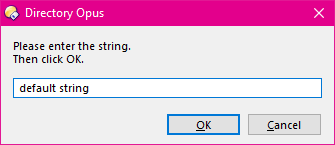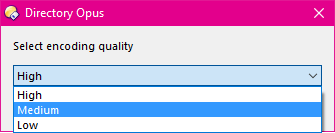The template for these codes is {code|<title>|<default>}. <title> specifies the title of the dialog box (a default title will be used if not provided), and <default> specifies the default filename.
For example, {dlgopen|Select filename|dopus.txt} would set the title to Select filename and the default filename to dopus.txt.
For {dlgopen} and {dlgmulti} you can specify a wildcard for <default> to set the filter type of the file dialog.
For example, {dlgopen||*.jpg;*.bmp;*.gif} would leave the dialog title as its default, and set the dialog to filter on .jpg, .bmp and .gif files.
For {dlgsave} you can specify an additional parameter to populate the "Save
as Type" dropdown list in the save
dialog.
For example,
{dlgsave|Title|Default Name.txt|type=#Text Files!*.txt!Doc
Files!*.doc}.
The # following the
type= causes the default "All files" items to be added to the
drop-down - take out the # if you don't want this. Following
that are one or more pairs of strings, separated by exclamation marks
(!). The first string of each pair is the plain text string
shown in the drop-down, and the second string of each pair is the actual file
extension. You can also specify multiple extensions for the one type by
separating them with semicolons - for example, type=JPEG
Files!*.jpg;*.jpeg.
These codes also support
the modifiers listed under Codes for passing filenames. To use
these modifiers, you must also include the <title> and
<default> parameters (they can be left blank if
desired).
For
example {dlgopen|||noext} would strip the
extension from the selected filename.
The template for this codes is {dlgfolder|<title>|<default>}. <title> specifies the title of the dialog box (a default title will be used if not provided), and <default> specifies the default filename.
For example, {dlgfolder|Select folder|C:\Users} would set the title to Select folder and the initial selected folder would be C:\Users.
This code supports the modifiers listed under Codes for passing paths. To use these
modifiers, you must also include the <title> and
<default> parameters (they can be left blank if desired). An
additional modifier, expand, is also supported. This causes the initially
selected folder to be automatically
expanded.
For
example {dlgfolder||C:\Program Files|expand} would
set C:\Program Files as the default folder and
automatically expand it in the displayed dialog.
The template for these codes is {code|<message>|<default>}. <message> specifies the message displayed in the dialog box, and <default> specifies the default value of the string field. You can include line-breaks in the message text using the special code \n (and if you need to include a literal \n sequence in the text you must escape the \ character, as in \\n).

For example, {dlgstring|Please enter the string.\nThen click OK.|default string}.
The optional doublequotes modifier can be used if you want any quote characters the user types to be doubled (" turns into ""). This must follow the <default> parameter, which should be blank if it is not used. Doubling quotes allows quote characters the user types to be included inside command parameters, provided there are explicit quotes around parameter itself.
For example, SetAttr META "comment:{dlgstring|Enter Comment||doublequotes}"
Additionally, {dlgpassword} accepts an optional confirm modifier, which must also follow the <default> parameter. If this is specified, the dialog will display two password fields, and you must enter the same value in both fields (as a confirmation) before the OK button will be enabled.
For example, {dlgpassword|Please enter your password twice.||confirm}.
If both doublequotes and confirm are needed at once, they can be specified in any order.
For example, {dlgpassword|Please enter your password twice.||confirm|doublequotes}"
The template for these codes is {code|<message>|<option 1>[=<value 1>][+<option 2>[=<value 2>]...]}.
<message> specifies the message displayed in the dialog box. You can include line-breaks in the message text using the special code \n (and if you need to include a literal \n sequence in the text you must escape the \ character, as in \\n).
<option 1> is the text displayed for the first option in the drop-down list, <option 2> is the second option, and so on. Multiple options are separated with a + sign.
<value 1> is an optional value associated with the first option. If provided, the option is displayed in the drop-down list, and the value is what is passed through on the command line. If values aren't provided, the option text is used for both.
You can specify the option which is selected by default by adding default: before it; otherwise, the first option (after sorting) will be the initial selection. You can also use the notdefault: prefix, which will simply be removed, if you need to use "default:" or "notdefault:" as a literal prefix.

For example, {dlgchoose|Select encoding quality|default:High=320+Medium=256+Low=128} would add the options High, Medium and Low to the drop-down list, with High as the initial selection, and would pass one of the values 320, 256 or 128 (respectively) through to the command line.
If you need to include a + or = character in either an option name or its value, you can do this by doubling the character up.